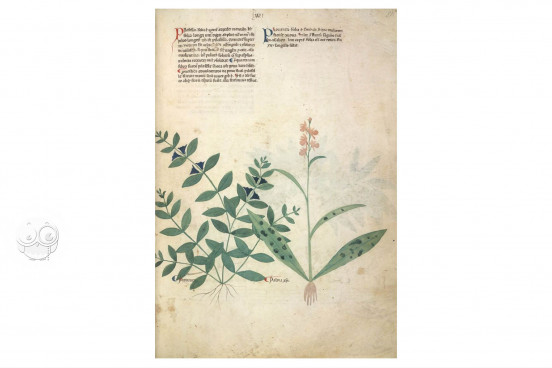The Egerton Tractatus de Herbis is an illuminated scientific manuscript comprising a vast store of European medical knowledge of the high Middle Ages. Copied and illuminated in southern Italy around 1300, it was made for a physician, an apothecary, or a teacher of medicine. It boasts two historiated initials with portraits of university masters. Its hundreds of column miniatures feature detailed paintings of medicinal plants, images of animals, and scenes with human figures.
The manuscript's principal text describes the appearance and curative properties of natural substances derived from plants and animals. A series of shorter texts follows, beginning with the Antidotarium Nicolai and including texts on compound medicines, dosages, weights, and measures.
Pictures of Professors
The opening pages of the Tractatus de herbis (fol. 1r) and the Antidotarium Nicolai (fol. 112r) are accorded special treatment. They are painted in a style reminiscent of the work of Jacobellus (also called Muriolus) of Salerno, who was active in Bologna and Salerno. Each page opens with a historiated initial featuring a portrait of a school master on a ground of gold leaf. Stylized painted vines extend from each initial, creating a handsome incipit page for each text.
Hundreds of Plants
Most of the manuscript's illumination is the work of at least two artists other than the painter of the incipit pages. There are hundreds of unframed images of plants. In principle, they are column miniatures, but they often extend beyond the vertical confines of the text columns.
Snakes, Spiders, and Scorpions
Although stylized and rendered with minimal shading, the plants are painted with enough accuracy—typically with the root structures visible—to be identifiable. When a simple medicine of the Tractatus is recommended for treating snake, spider, or scorpion bites or stings, the creature is often depicted in the margin of the page.
Animals and Minerals
The Tractatus is primarily devoted to plant remedies. The curative properties of animal and mineral substances are also described, and some of the manuscript's most charming images illustrate these chapters. The section on orpiment (trisulfide of arsenic), for example, is introduced by an image of the substance being mined and carried away in a basket (fol. 9r). A painting of a beehive illustrates honey (fol. 62v), and an image of a sperm whale illustrates the description of the curative properties of secretions from the beast's intestines (fol. 7r).
The Mystery of Bartholomeus Mini de Senis
The manuscript includes a colophon naming the book's scribe as "Bartholomaus Mini de Senis" and the compiler of its contents as "Bartholomeus" (fol. 106v). These names, however, are written over erasures. Perhaps Bartholomeus was an early owner of the book: he may have been responsible for writing some added (but nearly contemporary) headings in the Tractatus. A series of texts was added in cursive script following the Tractatus (fols. 109-112) in the mid-fourteenth century.
A Synthesis of Current Knowledge
The Tractatus opens with the preface to an earlier herbal, the Circa instans, but it is an expanded version of that text. It incorporates information from other sources, including herbals of classical antiquity.
Most conspicuous is the inclusion of excerpts from the Liber dietarium, Constantine the African's Latin translation of an Arabic treatise by Isaac Israeli. The writing of these passages—in a smaller script on initially blank parchment and in the margins—is contemporary with the larger text. We see, therefore, the scribe's active compilation of medical information from various sources.
Acquired by the British Museum
The Egerton manuscript came into the possession of the English scholar John Josias Conybeare (1779-1824). In 1839, the British Museum purchased it for its library with income from the Bridgewater Fund established by Francis Henry Egerton (1756-1829), Earl of Bridgewater. The manuscript was transferred to the British Library upon its establishment in 1973. It is preserved in its mid-nineteenth-century British Museum binding of red leather with gold-tooled decoration.
We have 2 facsimiles of the manuscript "Egerton Tractatus de Herbis":
- Tractatus de Herbis facsimile edition published by The Folio Society, 2002
- A Medieval Herbal facsimile edition published by British Library, 2003

